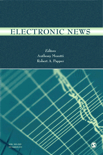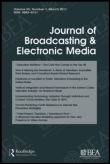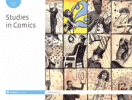
Journal of Print and Media Technology Research
Scope & Guideline
Shaping Tomorrow's Print and Media Landscape
Introduction
Aims and Scopes
- Print Technology Innovations:
Research focusing on novel printing technologies such as inkjet, flexographic, and gravure printing, including advancements in materials and processes. - Sustainability in Printing and Packaging:
Studies addressing eco-friendly practices in the printing and packaging industries, including the use of biomaterials and sustainable production methods. - Integration of Digital Technologies:
Exploration of digital transformations in print media, including the impact of artificial intelligence, machine learning, and automation on traditional printing processes. - Media Literacy and Education:
Research on the role of media literacy in education, focusing on developing competencies in information retrieval and usability for students. - Design and Aesthetics in Print Media:
Analysis of visual communication and design principles applied in print media, encompassing topics like color fidelity, visual language, and consumer perceptions.
Trending and Emerging
- Artificial Intelligence and Machine Learning:
Recent publications highlight the integration of AI and machine learning in print processes, particularly regarding color correction, prediction models, and automation, indicating a significant shift towards smart technologies. - Sustainable Practices and Materials:
There is an increasing focus on sustainability, with research exploring biodegradable materials, eco-friendly packaging, and innovative solutions for waste management in printing, reflecting industry trends towards environmental responsibility. - Impact of Digital Transformation:
The exploration of how digital transformation is reshaping the printing industry, including case studies and analyses of companies adapting to digital challenges, is becoming a prominent theme. - User Experience and Media Literacy:
Emerging discussions on user experience in print media and the importance of media literacy education suggest a growing recognition of the need for informed consumers in a digital age. - Interactive and Immersive Technologies:
The rise of interactive technologies and immersive experiences in print media, such as augmented reality and projection mapping, indicates a trend towards enhancing consumer engagement through innovative applications.
Declining or Waning
- Traditional Printing Techniques:
Research centered on conventional printing methods appears to be declining, with fewer studies published on techniques that do not incorporate newer technologies or innovations. - Historical Perspectives on Print Media:
While historical analysis remains important, the frequency of publications focused on the history of graphic design and communication technology has waned, reflecting a shift towards contemporary issues. - Basic Material Studies:
There has been a noticeable decrease in studies focusing solely on basic material properties, such as general paper characteristics, as the journal shifts towards more applied and technology-driven research. - Non-digital Media Formats:
Research related to traditional non-digital media formats is less prevalent, possibly due to the increasing digitization and integration of digital elements in print media.
Similar Journals

DESIDOC Journal of Library & Information Technology
Exploring the Intersection of Technology and Library SciencesDESIDOC Journal of Library & Information Technology, published by the Defence Scientific Information Documentation Centre, is a pivotal scholarly platform in the realm of Library and Information Sciences. The journal, indexed with ISSN 0974-0643 and E-ISSN 0976-4658, has established its reputation with a commendable Q3 category ranking in the latest Scopus quartiles and a notable rank of 113 out of 280 in its field, placing it in the 59th percentile. Engaging a global audience, it disseminates high-quality research insights aimed at advancing the practices and technologies within library and information management. Operating within a converged timeframe from 2012 to 2024, the journal is committed to fostering robust discussions surrounding contemporary issues in the field, making it an invaluable resource for researchers, professionals, and students alike. While currently not offering open access, its content is accessible through institutional subscriptions, reinforcing its significance in the academic community of India and beyond.

Computers in Human Behavior Reports
Advancing the dialogue between technology and human behavior.Computers in Human Behavior Reports, published by ELSEVIER, is a distinguished open-access journal dedicated to advancing interdisciplinary research at the intersection of technology and human behavior. Since its inception in 2020, the journal has quickly gained a prominent position in the academic field, attaining Q1 category rankings in multiple areas including Applied Psychology, Artificial Intelligence, Cognitive Neuroscience, Human-Computer Interaction, and Neuroscience (miscellaneous). Its robust standing is evidenced by its exceptional Scopus ranks, particularly in Neuroscience—where it is positioned 4th out of 49 journals—demonstrating a high level of influence and engagement within the community. The journal's aim is to disseminate cutting-edge research findings and foster dialogue among researchers, professionals, and students alike, thereby addressing crucial questions regarding the impact of technology on human behavior and vice versa. As an open-access publication based in the United Kingdom, it not only enhances the visibility of research but also ensures wider accessibility to groundbreaking insights that shape our understanding of human-machine interactions.

Journal of African Media Studies
Advancing Knowledge in African Communication.Journal of African Media Studies, published by INTELLECT LTD, stands at the forefront of communication research, focusing on the rich tapestry of media practices and theories across the African continent. Since its inception in 2011, this peer-reviewed journal has dedicated itself to exploring the intricate relationships between media, culture, and society in Africa, contributing significantly to the global discourse on communication. With an impressive impact factor positioning it in Q2 of the Communication category for 2023, and ranking #218 out of 511 in the Scopus Social Sciences Communication field, it offers a rigorous platform for scholars and practitioners alike. The journal's commitment to quality research is evident in its robust editorial process and its regular publication of articles that delve into contemporary issues affecting African media landscapes. Despite being a subscription-based journal, it attracts an engaged readership interested in accessing critical insights and advancing knowledge in media studies. As it converges its timeline towards 2024, Journal of African Media Studies continues to be an essential resource for researchers, professionals, and students eager to contribute to and explore the evolving narratives of African media.

Fonseca-Journal of Communication
Catalyzing Conversations in Contemporary Academic DiscourseFonseca-Journal of Communication, published by EDICIONES UNIV SALAMANCA in Spain, serves as a vital platform for the dissemination of scholarly research in the fields of Communication, Linguistics, and Social Sciences. Since its transition to Open Access in 2010, this journal has ensured that innovative ideas and research findings are accessible to a global audience, fostering knowledge exchange among researchers, professionals, and students alike. With an impressive ranking in various categories—Q3 in Communication, Q2 in Linguistics and Language, and Q3 in Social Sciences—the journal reflects its commitment to excellence and relevance in contemporary academic discourse. Its Scopus rankings confirm its growing impact in the linguistic and social research spheres, making it a valuable resource for those seeking to advance their understanding and contribute to scholarship in these fields. Through its rigorous peer-review process and diverse content, Fonseca aims to stimulate critical conversations and inspire future research.

Nordicom Review
Fostering Global Conversations in Media and CommunicationNordicom Review is a preeminent open-access journal published by SCIENDO, dedicated to advancing the field of communication studies. Established in Sweden, it has been at the forefront of disseminating scholarly research since its inception in 2000, providing a platform for innovative ideas and discussions. With an impressive impact factor that reflects its commitment to quality, the journal has achieved a remarkable Q1 rating in the Communication category for 2023, ranking 154 out of 511 in Scopus, placing it in the 69th percentile among peer-reviewed journals. The Nordicom Review embraces a broad scope, covering topics that intersect with media, communication policies, and societal implications, making it indispensable for researchers, professionals, and students alike. This journal supports the dissemination of knowledge and fosters dialogue among scholars, ensuring that crucial developments in communication are accessible globally.

Electronic News
Unveiling Insights in the Evolving Landscape of News Media.Electronic News, published by SAGE PUBLICATIONS INC, stands at the forefront of scholarly communication, focused on the dynamic intersection of media, technology, and society. With an ISSN of 1931-2431 and an E-ISSN of 1931-244X, this journal has established itself as a valuable resource for academics and professionals alike, exploring critical themes in communication and information systems. Operating from its base in the United States, Electronic News operates within a competitive landscape, boasting a commendable Q2 ranking in Communication and a Q3 ranking in Information Systems. This reflects its commitment to high-quality research and impactful insights, as evidenced by its Scopus rankings, where it ranks #238 out of 511 in Social Sciences Communication and #302 out of 394 in Computer Science Information Systems. Although currently embracing a traditional subscription model, the journal serves as a crucial platform for disseminating knowledge that shapes the future of news and media in a rapidly evolving digital age. As it converges from 2009 to 2024, Electronic News continues to invite contributions that address the multifaceted challenges and innovations of news media, making it an essential resource for researchers, practitioners, and students eager to engage with contemporary issues in communication.

JOURNAL OF BROADCASTING & ELECTRONIC MEDIA
Engaging Scholars in Critical Media DiscourseThe JOURNAL OF BROADCASTING & ELECTRONIC MEDIA, published by Routledge Journals, Taylor & Francis Ltd, is a premier academic publication in the field of communication, officially recognized in the Q1 category for its exceptional quality and impact. With a rich history dating back to 1985, this journal serves as a vital platform for innovative research and critical discussions surrounding broadcasting and electronic media, addressing contemporary issues in digital communication, media technology, and audience studies. The journal boasts an impressive Scopus rank of #73 out of 511 in the Social Sciences - Communication category, placing it within the top 15% of its field. Researchers, professionals, and students alike benefit from its insightful articles that contribute to understanding the evolving landscape of media and communication. Although it does not currently operate under an Open Access model, its rigorous peer-review process ensures that published works meet high academic standards, sustaining its reputation as a cornerstone for scholarly discourse in the media industry.

Online Journal of Communication and Media Technologies
Advancing the Frontiers of Communication and Media ResearchThe Online Journal of Communication and Media Technologies, published by Bastas Publications DOO in Cyprus, stands as a crucial platform for scholars and practitioners in the rapidly evolving fields of communication, media, and technology. With an ISSN of 1986-3497, this journal addresses a diverse range of topics at the intersection of these disciplines, making significant contributions to both theoretical frameworks and practical applications. As a recognized entity in the academic community, it boasts impressive rankings in Scopus, such as Q2 in Communication and Q2 in Media Technology, illustrating its impact and relevance. Researchers will appreciate its open access model, which facilitates knowledge dissemination and engagement among audiences. By fostering a collaborative environment for innovative ideas and research findings, the journal not only advances academic inquiry but also supports the professional development of its readership in navigating the complexities of modern media landscapes. Aiming to bridge the gap between theory and practice, the Online Journal of Communication and Media Technologies is an essential resource for those who wish to stay at the forefront of communication and media research from 2019 through 2024.

Studies in Comics
Illuminating the Intersection of Literature and Visual ArtsStudies in Comics, published by INTELLECT LTD, is an esteemed journal situated at the intersection of Literature and Visual Arts, with a dedicated focus on the comic form. Operating since 2019, this journal has quickly established itself as a respected resource in both the Literary Theory and Visual Arts and Performing Arts categories, boasting a commendable Q2 ranking in 2023 within these fields. With an ISSN of 2040-3232 and an E-ISSN of 2040-3240, it provides a platform for rigorous scholarship that explores the multifaceted dimensions of comics, promoting interdisciplinary approaches that enrich understanding and foster dialogue among researchers, professionals, and students. With a notable position in the Scopus Ranks, being in the 84th percentile for Literature and 73rd for Visual Arts, the journal is committed to advancing the study of comics as a significant cultural artifact and artistic medium.

International Journal of Marketing Communication and New Media
Unveiling the latest trends in marketing communication.Welcome to the International Journal of Marketing Communication and New Media, a premier platform dedicated to advancing the field of marketing communication in the rapidly evolving digital landscape. Published by the esteemed INST SUPERIOR ENTRE DOURO & VOUGA in Portugal, this journal facilitates an invaluable exchange of research and insights among scholars, practitioners, and students. With an ISSN of 2182-9306, it aims to explore innovative marketing communication strategies and new media applications, making a significant impact in the realms of advertising, public relations, and digital marketing. Although the journal operates under a subscription model, it remains committed to disseminating high-quality, peer-reviewed research that reflects current trends and challenges in the marketing industry. By contributing to this journal, you will join a vibrant community of thought leaders dedicated to shaping the future of marketing communication.